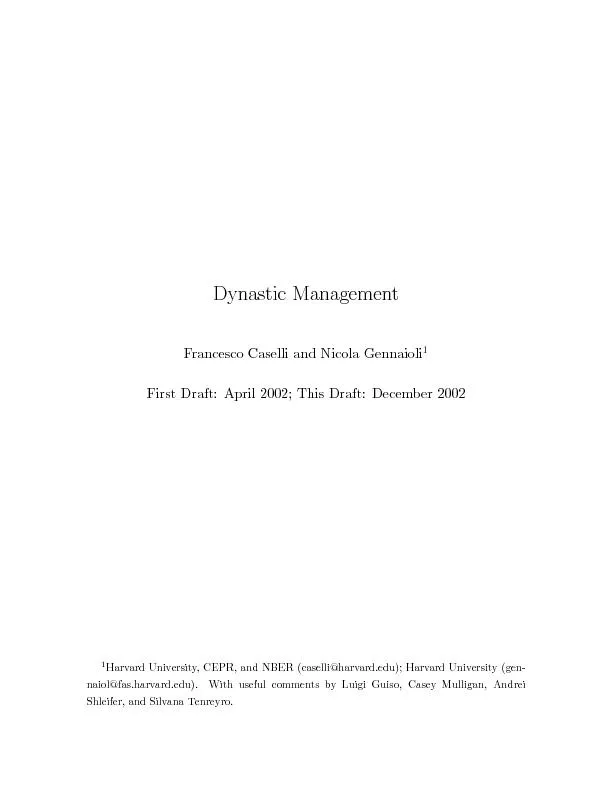

AbstractDynasticmanagementistheintergenerationaltransmissionofcontroloverassetsthatistypicaloffamilyownedrmsItispervasivearoundtheWorldbutespeciallyindevelopingcountriesWearguethatdynasticmanagem ID: 341722
Download Pdf The PPT/PDF document "DynasticManagementFrancescoCaselliandNic..." is the property of its rightful owner. Permission is granted to download and print the materials on this web site for personal, non-commercial use only, and to display it on your personal computer provided you do not modify the materials and that you retain all copyright notices contained in the materials. By downloading content from our website, you accept the terms of this agreement.
DynasticManagementFrancescoCaselliandNicolaGennaioliFirstDraft:April2002;ThisDraft:December2002HarvardUniversity,CEPR,andNBER(caselli@harvard.edu);HarvardUniversity(gen-naiol@fas.harvard.edu).WithusefulcommentsbyLuigiGuiso,CaseyMulligan,AndreiShleifer,andSilvanaTenreyro. AbstractDynasticmanagementistheinter-generationaltransmissionofcontroloverassetsthatistypicaloffamily-ownedrms.ItispervasivearoundtheWorld,butespeciallyindevelopingcountries.Wearguethatdynasticmanagementisapotentialsourceofciency:iftheheirtothefamilyrmhasnotalentformanagerialdecisionmaking,meritocracyfails.Wepresentasimplemodelthatstudiesthemacreconomiccausesandconsequencesofthisphenomenon.Inourmodel,theincidenceofdynasticmanagementdependsontheseverityofasset-marketimperfections,ontheeconomyssavingrate,andonthedegreeofinheritabilityoftalentacrossgenerations.Wethereforeintroducenovelchannelsthroughwhichnancial-marketfailuresandsavingratesaectaggregatetotalfactorproductivity.Numericalsimulationssuggestthatdynasticmanagementmaybeasubstantialcontributortoobservedcross-countrydierencesinproductivity. 1IntroductionThereisbroadagreementthatdierencesinaggregateTotalFactorProductivity(TFP)constitutealargefractionoftheexistingcross-countrydierencesinper-capitaincome.Thatis,notonlydopoorcountrieshavefewerproductiveresources,suchasphysicalandhumancapital,buttheyalsoemploythoseresourceslesseectivelythanrichcountries.Naturally,then,attentionisincreasinglyturningtopotentialexplanationsfortheseTFPdierences,andvariousauthorshaveemphasizedlagsintechnologyusion,inappropriatetechnology,ethnicconict,geography,vestedinterestsandotherinstitutionalfailures,andseveralothercauses.Webelieve,however,thatapotentiallycriticalsourceofineciencyhassofarbeenlargelyoverlooked:failuresofmeritocracy.Individualsaremanifestlyheterogeneousintheirdecision-makingskills.Dier-encesacrosscountriesintheaccuracywithwhichthebestdecisionmakersareselectedforimportantdecision-makingresponsibilitiesi.e.dierencesinmeritocracycanclearlyresultintodierencesinthereturnscountriesreapfromtheirproductivere-sourcesi.e.dierencesinTFP.Meritocracycanfailspectacularlyinthepublicsector.Butmeritocracycanalsofailintheprivatesector.Thispaperstudiesthemacroeco-nomiccausesandconsequencesofaparticularprivate-sectornon-meritocraticprac-tice:theinter-generationaltransmissionofmanagerialresponsibilitiesinfamilyrms,awidelyobservedphenomenonthatwecalldynasticmanagement.Inafrictionlessworldthereislittleeconomicjusticationforthefactthatmanyrmsaremanagedbytheirowners.Whiletheallocationofcashowrightsshoulddependonthedistributionofwealth,andonincentivesforriskdiversication,theallocationofmanagerstormsshouldmainlydependonthedistributionofmanagerialtalent(presumably,withmoretalentedmanagersmanaginglargerassetsasinLucas,1978).Inreality,itveryoftenoccursthattheownershipofrmsisconcentratedinfew SeeIslam(1995),Caselli,Esquivel,andLefort(1996),KlenowandRodriguez(1997),HallandJones(1999),ParenteandPrescott(2000),Hendricks(2002),CaselliandColeman(2002),andCaselli(2003).Non-meritocracyinthepublicsectorisstudiedinCaselliandMorelli(2002).OurnotionoffailuresofmeritocracyisdistinctfromtheproblemofsociallyinecientallocationoftalentstudiedbyMurphy,Shleifer,andVishny(1991).Theyareconcernedwithsituationswerethemosttalentedindividualssucceedatmaximizingtheprivatereturnontheirabilities,butthisdoesnotleadtosocial-returnmaximization.Failuresofmeritocracy,instead,aresituationswherethetalentedarepreventedfrommaximizingboththeprivateandthesocialreturnoftheirskills. handsoftenmembersofafamilyandthatthesefamily-ownedrmsaremanagedbyfamilymembers.Thecombinationoffamilyownershipwithfamilymanagementgivesrisetodynasticmanagement:notonlythepropertyoftheasset,butalsoitsmanagement,passesonacrossgenerationsofthesamefamily.Thispracticeexistsvirtuallyeverywhereintheworld,butismuchmoreprevalentinpoorercountries.Itisclearthatatanypointintimetheidenticationofownershipandman-agementimpliesapotentialineciency,ifthedistributionsoftalentandwealthdonotcoincide.Whenonenoticesthedynasticaspectofsuchidentication,however,theciencygoesfrombeingpotentialtobeingavirtualcertainty:evenallowingforselfselectedinitiatorsoffamilybusinesses,unlessmanagerialtalentisperfectlycorrelatedacrossgenerations,itisinevitablethatassetswillsoonerorlaterendupinthewronghands,i.e.thoseofamanageriallyineptdescendant.Weproposeagrowthmodelwheredynasticmanagementarisesendogenously,andlookattheconsequencesofthisfailureofmeritocracyforthedynamicevolutionofTFPandcapitalaccumulation.Inourmodelthefrictionsthatgiverisetodynasticmanagementarefeaturesofacountrysnancialandcontractualinfrastructure.Untalentedheirsoffamilyrmswouldliketotransfercontroltonewtalentedowners,orhiretalentedmanagers.However,imperfectnancial-contractenforcementdiscouragesownershipchanges,andcostlymonitoringmakesitdiculttowritemanagerialcontracts.Sincetheseverityoftheseimpedimentstothetransferofcontroldependsontheseverityoftheasset-marketimperfections,cross-countryvariationinthelatterwillleadtocross-countryvariationintheincidenceofdynasticmanagement,andofTFPwithit.Hence,thepaperbringsoutanovelchannelthroughwhichnanceaectsdevelopment. Analternativewaytogeneratedynasticmanagementistoassumethatmembersofafamilythathashistoricallybeenassociatedwithaparticularrmderiveasenseofidentityfromcontinuingintheassociation(see,e.g.,Mann,1901).Thisisequivalenttoputtingthefrictionsintheutilityfunction,andwouldgeneratedynasticmanagementevenineconomieswithperfectlyecientnancialmarkets,asfamilieswouldbemoretoleranttowardsuntalentedheirs.However,cross-countrydierencesintheincidenceofthephenomenonshouldstillvarywithnancial-marketimperfections,asthereshouldbethresholdsofineciencythatwouldbeintolerabletoeventhefamilieswithgreatestattachmenttorm.Furthermore,theimplicationsofdynasticmanagementforaggregateeciencyandgrowthwouldbesimilar.Another,morebenign,viewofdynasticmanagementisthatitiseasiertotransmitrm-specicmanagerialhumancapitaltoonesospringthantooutsiders.Aswewilldiscuss,theempiricalevidenceisratherunfavorabletobenignviewsofdynasticmanagement.Moreover,eveniffamilymembersdohavegreaterrm-specichumancapital,itshouldonceagainbestillbetruethatbelowacertainleveloftalenteciencystillrequiresatransferofcontrol.Hence,thesealternative Besidestheeciencyofnancialmarkets,twootherfactorsthatinuencethedynamicpropertiesofthemodelaretheintensityofthebequestmotiveacrossgener-ationsakintoaSoloviansavingrateinthecontextofourmodelandthedegreeofintergenerationalheritabilityofmanagerialtalent.Ahighersavingrategenerallyimpliesgreaterbequestsreceivedbypotentialbuyersofrms.Sinceinourmodelthesebequestsareusedascollateral,inordertoovercomecontractualimperfections,thistendstofacilitatethetransferofcontrolrightsamongrms,andhencetendstoenhanceeciency.Therefore,themodelalsouncoversanovelsourceofcausationfromsavingtoproductivity.AhigherdegreeofheritabilityofaparentstalentbyherospringalsoincreasesTFP.Toseethis,considertwoextremecases:thecasewheretalentisperfectlycor-relatedacrossgenerations,andthecasewherethetalentofeachgenerationisdrawnfromindependentandidenticaldistributions.Withperfectcorrelationoftalentthein-cienciesassociatedwithdynasticmanagementbecomelessandlessimportantovertime,andeventuallydisappear.Thisisbecause,inourmodel,well-runrmsincreaseinsizerelativetotheaveragermsize,whilebadly-runrmsshrink.Sincetalentisperfectlypersistentthisimpliesthatasymptoticallywell-runrmsaccountfor100%ofthecapitalstock.Notsointhecasewheretalentisindependentlydistributedacrossgenerations:heretheinecienciespersistinthelongrun,asineveryperiodsomelargermsareinheritedbysomelow-talentindividuals,whowillinturnholdontocontrol.Intermediatecasesgenerateintermediateamountsofsteady-stateineciency.Besidesthekeyinsightsdescribedabove,themodelfeaturesawealthofaddi-tionaltestableimplications.First,wendthattheseverityoftheeectofnancialimperfectiononopportunitiesfortransfersofcontroldependsonthermssize.Ceterisparibus(i.e.foragivendegreeofcontractualimperfection)theineptownersofsmallrmsaremorewillingtopartwiththeirassetsthantheineptownersoflargerms.Intuitively,theoutsideoptionrepresentedbythelabormarketisamoreviablealter-nativewhenoneispartingwithasmall-scalebusinessthanwhenoneisrelinquishingcontroloveralargeempire.Furthermore,asmallercollateralisrequestedtopurchaseasmallrm,somoreagentsintheeconomycancollateralizethepurchaseofsmallrmsthanoflargerms.ThissizeeecthasinterestingandnovelimplicationsfortherelationbetweenthesizedistributionofrmsandTFP.Foragiveneconomy-widecap-italstock,afewlargermsimplyalargerconcentrationofassetsininepthandsthan storiesmaymitigate,butnoteliminate,theeciencycostsofdynasticmanagement. inthecaseofmanysmall-sizedrms:countrieswithmoreconcentratedownershipwillbelessecient.Inaddition,thereareinterestingfeedbackeectsbetweentheassetmarketandthelabormarket.Forexample,thelargertheoverallfractionofthecapitalstockthatismanagedcompetently,thehigherisaggregateTFP,andthusthehigheristheaveragewageintheeconomy.But,inturn,ahigheraveragewagemakesitlessprotableforalow-talentownertoholdontomanagerialresponsibilities,leadingtoevenmorermsbeingtransferredtotalentednewowners:thebenecialeectonTFPisthusmagnied.Thehigheraveragewagealsotranslatesintogreaterbequests,andhencemoreopportunitiesforcollateralizedcontroltransfers,furtherreinforcingthisvirtuouscycle.Weconcludethepaperwithnumericalsimulationsaimedatassessingthepo-tentialquantitativerelevanceoftheproblemofdynasticmanagement.Underareason-ablecalibrationoftheparameterthatregulatestheinter-generationalinheritabilityoftalent,wendseverepotentialconsequencesofdynasticmanagementonTFP.Inpar-ticular,thischannelalonecancauseacountrywithveryinecientnancialmarketstohaveTFPlevelsaslowas80%oftheTFPlevelsofacountrywithwellfunction-ingmarkets.Thesimulationsalsogeneratelargevariationsinsteadystatecapitalstocks.Finally,theshapeofthesteadystatesizedistributionofrmspredictedbythesimulationsisremarkablyconsistentwithempiricalevidence.2LiteratureReview2.1EmpiricalInthissub-sectionwereviewempiricalstudiesthatdocumentthefollowingfacts:(i)Familyownershipandfamilymanagementarepervasivearoundtheworld,particularlyindevelopingcountries,andincountrieswithinecientassetmarkets;(ii)Dynasticsuccessionisonaverageassociatedwithdeclinesinperformance,bothatthemicroandatthemacrolevel;(iii)Thereisastrongpositivecross-countryrelationbetweennancialdevelopmentandgrowth.Allthreesetsoffactsareimportantpredictionsofourmodel.Familyownershiparoundtheworld.Themostcomprehensivedataoncor-porateownershiparoundtheworldhasbeencollectedbyLaPorta,De-Silanesand Shleifer(1999),wholookatthecontrolstructureofthe20largestpubliclytradedcompaniesin27(mostlywealthy)economiesin1995.Onaverageacrossthesecoun-tries,familyownershipisthecontrolstructureof30%ofcompanies.Thenumbersforthemiddle-incomecountriesinthesampleareespeciallystriking:65%inArgentina,50%inGreece,100%inMexico,45%inPortugal;onlySouthKorea,witha20%inci-dence,isbelowtheWorldaverage.Furthermore,inalmost70%ofthefamily-ownedrmsthecontrollingfamilyisdirectlyinvolvedinmanagement(CEO,HonoraryChair-man,Chairman,orVice-Chairman).Becausethisisbasedoncomparisonsofthelastnamesofmanagersandowners,itprobablyconstitutesanunderestimate.Finally,countrieswithlowinvestorprotectionexhibita12%highershareoffamilyrmsthancountrieswithhighinvestorprotection.Byfocusingonlyonpubliclytradedcompanies,andonlyonmiddle-to-highincomecountries,LaPorta,De-Silanes,andShleiferalmostcertainlyunderestimatetheworld-wideimportanceoffamilyrms.The3,033respondentstotheArthurAndersen/Mass.MutualAmericanFamilyBusinessSurvey97accountforcombinedrevenuesof$67.4billion,medianrevenuesof$9million,andmodalrevenuesof$10million,suggestingthatfamilybusinessesaccountforanimportantfractionofeventheUSeconomy.AccordingtoTheEconomist,twothirdsofGermanyssmallandmediumbusinesses(Mittelstand)aremanagedbytheowners(October15th,1998),and40%ofmanagerialsuccessionsinvolvearelativeofthedepartingCEO(December13th,2001).Dreux(1990)andGersicketal.(1997),usingconservativeestimates,claimthattheproportionofrmsownedormanagedbyfamiliesintheworldisbetween65and80%.PerrowandLansberg(1990)emphasizetheimportanceofthesocalledLatinAmericangrupos,largeindustrialgroupsdiversiedonseveralsectorsthatremainunderthetightcontrolofthefounderandofhisheirs,andresorttoverylittleoutsideequitynanciers.TheEconomistreportsthatfamilyrmsgenerate70%oftotalsalesandnetproofthebiggest250Indianprivatecompanies(October5th,1996),andthatthetop15familiescontrolover60%oflistedcorporateassetsinIndonesia,between50and60% Itisfuntogothrougha(veryincomplete)listofmajorUScorporationswherethedescendantsofthefounderstillholdcriticaldecision-makingpositions:Hewlett-Packard,Wal-Mart,Motorola,Nordstrom,Coca-Cola(theglobalsymbolofAmericancapitalism),Ford,IBM,andTheNewYorkTimes(TheEconomist,November17th,2001).Inthisstudyafamilyrmisidentiedashavingauniqueprivateshareholderwhocontrolsmorethan20%ofthevotingrights.Thisisclearlyaveryrestrictivecriterion,asmuchsmallervotingsharesareusuallysucienttodeterminecontrol. inthePhilippinesandThailand,over30%inSouthKoreaandHongKong,andover20%inSingapore,Malaysia,andTaiwan(April7th,2001).Dynasticsuccessionandperformance.Clearlythispapertakesafairlyneg-ativeviewofdynasticmanagement,andsomeformalpiecesofempiricalevidencelendsupporttothisview.Volpin(2002)examinesthedeterminantsofexecutiveturnoverrmvaluationforallItaliantradedcompaniesfrom1986to1997,andndsthatpoorgovernanceasmeasuredbothasalowsensitivityofexecutivesturnovertoper-formance,andasalowQratioismorelikelywhenthecontrollingshareholdersarealsotopexecutives.AsimilarresultisfoundfortheUS.byDenisandDenis(1994).Alongsimilarlines,Perez-Gonzales(2001)examinesasampleofCEOtran-sitionsinfamilyrms.HedenesafamilyrmasonewheretheretiringCEOisrelatedtothermsfounder,andndsthatwhentheincomingCEOisrelatedtotheretiringCEOthermsperformancesuers,relativetothecasewhereincomingandretiringCEOsareunrelated.Forexample,returnsonassetsintheinheritedcontrolcasesfall20%withintwoyearsofthenewCEOstenure,whileinunrelatedtransi-tionstheydontchangemuchonaverage.HealsondsthatcaseswhereinheritedcontrolisaccompaniedbydeclinesinperformancearelargelyexplainedbythepooracademicrecordoftheinheritingCEO.Thissuggestsconsistentagainwiththeviewemphasizingproblemsofmanagerialqualitythattheeciencylossesarelinkedtothemanagerialabilities(orlackthereof)oftheheir.TheseresultsarealsoconsistentwiththoseobtainedbyMorck,StrangelandandYeung(2000),wholookatasampleofCanadianrmsmanagedbyheirsofthefounderandndthattheyunder-performsimilarUS.rmswithdispersedownership.TheMorck,StrangelandandYeungstudyalsocontainsamacroeconomicver-sionofthistest.TheyuseinformationfromForbes1000toshowthatcountriesinwhichbillionairesheirswealthislargewithrespecttoGDPgrowlessthancountrieswhereitissmall.Ontheotherhand,countrieswherethewealthofself-madebusiness Consistentwithourmodel,thestoryonIndiaalsospeculatesthatnewregulationsaimedatenhancingtheprotectionofminorityshareholderswillleadtoarelaxationofthestrangleholdoffamiliesontheeconomy.However,healsondsthatrmssize(asmeasuredbyassets)doesnotpredictdynasticsuccession,whichisinconsistentwithourmodel(wheredynasticsuccessionshouldbemorelikelyinlargerrms).Thisresultisnotconclusive,however,ashissampleiscensored:itonlyincludesrmswithmorethan5milliondollarsinsales.Itcouldbethattheprobabilityofdynasticmanagementattensoutaboveacertainsizethreshold. entrepreneursbillionairesislargewithrespecttoGDP,growmorethancountrieswhereitissmall.Theseresultsseemtosuggestthathysteresisofcontrolalongdynasticlinesisanimportantdeterminantofmacroeconomicperformance.FinanceandGrowth.KingandLevine(1993)documentedapositiveasso-ciationbetweennancialdevelopmentandeconomicgrowth.Sincethentheirndingshavebeenreplicatedmanytimesover,mostnotablybyRajanandZingales(1998),whousedaninstrumental-variableapproachtomakeconsiderableprogresstowardses-tablishingacausallinkbetweenthetwo.Traditionally,theliteraturetendstoexplainthesendingsintermsofcoordinationofsavingandinvestmentdecisions:nancialmarketsmustallocatefundstothebestprojects.Inthecontextofourmodelthere-sultemergesinsteadthroughthereallocationofmanagerialcontrolofalreadyexistingassetstomoretalentedagents.2.2TheoreticalIneconomics,familyrmstendtobeviewedassecond-bestsolutionstoagencyproblems.Chami(2001)viewsthefamilyrmasaprincipal-agentrelationshipbetweenpar-ent/ownerandchild/employee.Trust,altruism,andtheprospectofsuccession(thatmakesthesonaclaimanttofutureprots)allmitigatetheagencyproblem,relativetothesituationwheretheparenthiresoutsideemployees.Heabstractsfromthepos-sibilitythatthechild(andheir)isuntalented.Thispossibility,instead,isconsideredbyBurkart,PanunziandShleifer(2002),whoviewfamilycontrolasaresponsetopoorshareholderprotection.Incountriescharacterizedbyrampantexpropriationofshareholdersbymanagers,theownersofproductiveassetsprefertoholdontocontrol,evenifanoutsidemanagerwouldbebettersuitedtoruntherm.Clearlyourpapertakesthesameviewofthesecond-bestproblemsolvedbyfamilyrmsasBurkart,PanunziandShleifer(2002).Ourcontributionistotakethestaticandpartial-equilibriummodeloffamilysuccessionwithpoorinvestorprotection,andembeditinageneralequilibriumgrowthmodel,whereweformalizetheinterac-tionsbetweenthelabormarketandtheassetmarket,thestochasticprocesslinkingthetalentsofparentsandchildren,andthemechanismsthatgiverisetocapitalaccumula-tionovertime.Thisallowsustostudytheimpactoffamilyrmsonlong-runaggregate Contributionsinbusinessandsociologyemphasizetheimportanceofsharedculturalvaluesandcommonbeliefsinfosteringcommitmentandlongrunplanning(Gersick1997,Lansberg1983,Davis1983). ciencyandcapitalaccumulation,athemethathasnotsofarbeenexploredineitherthecorporatenanceorthegrowthliterature.Asthereisanempiricalliteratureonnanceandgrowth,soisthereatheoreticalone.Bystressingnancialimperfectionsasoneofthesourcesofdynasticmanagement,clearlyourpaperisacontributioninthiseld.Particularlyrelatedtooursaremodelswherenancialimperfectionsaectoccupationalchoice,suchasBanerjeeandNew-man(1993),Ghatak,Morelli,andSj¨ostr¨om(2001),andespeciallyGhatak,Morelli,andSj¨ostr¨om(2002).Inthelatterpaper,asinours,collateralconstraintsimplythatrich-but-untalentedindividualsoccupymanagerialpositions,whilepoor-but-talentedonesareworkers.Anothersimilarityisthatthewageratecreatesafeedbackeectbetweenthelabormarketandtheallocationoftalent,creatingthepotentialformul-tipleequilibriaanddevelopmenttraps.Indeed,thismultiplicityisthemainfocusoftheir(static)model.Wearemoreinterestedinintergenerationallinkages,andhenceintheeconomysdynamics.3TheModelWestudyaneconomyindiscretetime.Ineachperiodthereisacontinuum(ofmeasure1)ofone-period-livedindividuals.Anindividualsmanagerialtalentiscanbe ,orlow, isthefractionofagentsoftype .Eachagentengagesinasexualreproductionofoneospring,whowilllivenextperiod.Tothisospringtheagentbequeathsafractionofhisorhercurrentincome,whileconsumingtherest.Eachagentobjectiveistomaximizecurrentincome.Theeconomyisendowedwithameasurerms.Eachcombinesmanagerialinputwithcapitalandlabortoproduceoutputaccordingtotheproductionfunction:Thekeyassumptionisthattheeciencylevelectstheabilityofthemanager: Ontheotherhand,ourmicro-modeloffamilysuccessionismuchmorerudimentarythantheoneofBurkart,Panunzi,andShleifer(2002).Forexample,theirsisrichenoughthattheycandistinguishbetweentwotypesoffamilyrms:thosewherebothownershipandmanagementarekeptinthefamily,andthosewherethefamilymaintainsalargecontrollingstake,andexploitittokeepaparticularlywatchfuleyeontheoutsidemanagerithires.Theyndthattheformertypeoffamilyrmprevailsnacialmarketsareveryundeveloped,andthelatterwhentheyareatintermediatestagesofdevelopment(thewidelyownedcompanyprevailswhenmarketsarehighlydeveloped). ifthemanageristalentedthen ,ifheisnot,then .Eachrmmusthaveonemanagerandeachmanagercanonlymanageonerm.Investmentsincapitalareirreversibleandrm-specic:existingcapitalcannotbereallocatedamongrms,norconvertedbackintoconsumption.Hence,armscapitalchangesonlythroughnewinvestment(anddepreciation).Weassumethattimeisrequiredtobuild,soinvestmentdecisionschangethecapitalstockwithaoneperiodlag.Asaresultofthissetofassumptions,inagivenperiodisastatevariablefor.Finally,thenumberofrms,,isgivenandconstant.Wealsoassumesothatineciencydoesnotarisetriviallyforlackofasucientnumberofpotentialtalentedmanagers.Giventhissetup,fortheeconomyasawholethestatevariablesatthebeginningofeachperiodarethesizedistributionofrms,andtheirallocationtoownerswithdierenttalent.Giventheseinitialconditions,ineachperiodthefollowingsequenceofeventsandactionstakeplace.First,amarketfortheownershipofmeets.Individualscanbuy(sharesin)rmsinexchangeforunitsofoutput,orinexchangeforpromisestodeliverunitsofoutputattheendoftheperiod.Thismeetingoftheassetmarketdeterminesanewdistributionofownership.Ownersthenturntothelabormarket,whereeachrmhiresworkersatacompetitivewage,.ThisdeterminesTheresourcesoftheeconomyhavingthusbeenallocated,productiontakesplace,givingriseforeachrmtooutputandpro.Itisherethatthecontractualfrictionsbite.Peoplewhohaveborrowedtobuysharesinrmsdecidewhetherornottorepaytheirdebts.Courtsinthiseconomyhavetheabilityofseizingafractionoftheresourcesofapartyinviolationofcontractualcommitments,suchasadebtorthatfailstorepaythecreditorinfull.Defaultdecisionstakethisfactintoaccount,anddeterminetheend-of-perioddistributionofincome.Giventheirincomes,agents Theone-manager,one-rmassumptionsimpliestheanalysisbutisnototherwisecrucial.Itcanbejustied,however,onthegroundthatamanagerstimeandenergyarelimited.Similarly,allowingforreversibilityofcapitalwouldcomplicatethings,butnotchangethemainconclusions.Atthesametime,irreversibilityofthekindweproposeisalsonotunrealistic.Theimportantassumptionisthatthenumberofrmsisxed,whichallowsustoabstractfromissuesofentry.Acaponthenumberofrmscouldbeendogenizedinthismodelbyintroducing(sucienclylarge)xedcostsofentry,whichdoesnotseemunrealistic,especiallyindevelopingcountries.Inthepresentcontextwithnoentryonecanthinkofasthenumberoflicenciesissuedbythegovernemnttooperateplants.Oronemaythinkofthemasaxednumberoftrees,wherethegrowthandyieldofthetreedependsonthegardenersability. proceedtoallocateittoconsumptionandbequestsasdetailedabove.InAppendixA.1wefurtherextendthismodeltoasituationwhereasanalternativetosellingthermuntalentedrmownerscantransfercontrolbyhiringatalentedmanager.Weshowthatthisextensiondoesnotchangeourqualitativeresults.Thereasonisthatmanager-ownerrelationshipsarealsogenerallymoreorlessviable,dependingonthequalityofaneconomyscontract-enforcementinfrastructure.Countrieswherethecourtshaveadiculttimeenforcingdebtcontracts,willalsohaveadiculttimeprovidingmanagerswiththeincentivesnottostealarmsprotsifnotitsassetsfromtheowner-principal.Hence,whenonesolution(transferofownership)isunfeasible,somoreoftenthannotistheother(hiringamanager).4StaticEquilibriumInthissectionweabstractfrombequestsandosprings,wetakethestatevariables(initialdistributionofamongindividuals)asgiven,anddeterminethestaticequilibriumallocationofmanagerialtasksandoveralleciency.Inthenextsectionwelookatthedynamicimplications.4.1LaborMarketItisusefultobeginbycharacterizingrmsbehavioronthelabormarket.Allrmown-ersseektomaximizeprots,whichinourcontextaregivenbytakingthewageasgiven.Theresultinglabordemandfunctioncanbeaggregatedamongrms,andtheaggregatelabordemandfunctionturnsouttobe w¶1 µs 1 + s 1 whereistheaggregatecapitalstock(or isthefractionoftheaggregatecapitalstockinrmsrunbyincompetentmanagers[ =Ri;Ai= (Ki isthefractionofrmsruncompetently[ =Ri;Ai= ].Notethat .Itshouldalsobeclearthattheterm 1 + s 1 isameasureoftheaverageeciencyintheeconomy.Thismakestheaggregatelabordemandfunctionveryintuitive.Becausetherearermsafractionofthepopulationworkasmanagers.Hence,theremaining1constitutestheaggregatelaborsupply.Settinglabor demandequaltolaborsupply,wecansolvefortheequilibriumwagerate:=(1 1f!µs 1 + s 1 Theequilibriumwagedependsontheaggregatecapital-laborratio,),andonthewaythecapitalstockisdistributedbetweentalentedandnon-talentedowners:thegreater ,thegreatertheoveralleciencyoftheeconomy,thehigherworkerswages.Pluggingthermslabordemandandthewagefunctionsintheexpressionforrmsoutput,andaggregatingacrossrms,weobtainthefollowingexpressionforaggregateGDPperworker: 1f=ÃK 1f!µs 1 + s 1 where.Thisillustratestheniceaggregationpropertiesofthemodel:despitetheexistenceofarbitraryheterogeneityinthermdistributionofcapitalandeciency,aggregateoutputcanbedecomposedintothecontributionsofcapitalintensity,andaTFPterm, 1 + s 1 .TFPinthismodelisentirelydeterminedbythefractionofthecapitalstockthatismanagedeciently, (andbythedierenceinrm-levelTFPbetweentalentedandnon-talentedowners, / ).Thismakes theendogenousvariableofgreatestinterestinthispaper.sprotsaregivenby i (s 1 + s 1 )Ki whereisaggregateprots.Hence,theshareofaggregateproisabletocaptureisincreasinginthermsrelativesizeandinmanagerialtalent,Also,andmostnotably,isdecreasingin :throughtheaggregatewagethequalityofmanagementinotherrmsgeneratesanexternalityonsownprotability.4.2MarketforFirmsEquilibriumprotsandaggregateeciencydependonthemanagerialtalentoftheowner.Managerialresponsibilitiescanbere-allocatedfromlow-tohigh-talentindi-vidualsthroughtransferofownership.Inthissectionweassumethatindividuals(other ConsistentwiththeCobb-Douglasavorofaggregateoutput,itcanalsobeshownthatprotsareafractionofaggregateoutput,or.Itfollowsthattheaggregatewagebillis(1 rmowners)begintheperiodwithnoassets,andhencetheonlywayforthemtopurchaseownershiprightsonarmisthroughadebtcontract.Wewillrelaxthisrestrictionwhenweintroducebequestsinthenextsection.Thesalecontractforspeciesapricethatthebuyerwilltransfertothesellerattheendoftheperiod.Thebuyerwillnancethisrepaymentoutoftheproowfromtherm.Tominimizeincentivestodefaultthecontractspeciesthat,ifthebuyerfailstorepay,thesellerisentitledtoseizingtheproowfromtherm.However,theenforcementofcontractsisimperfect.Inparticular,everytimeapartytoacontractisindefaultofhiscontrac-tualobligations,courtsareonlyabletoseizeandtransfertotheplaintiafractionofthedebtorsresources.ThereforewewillobservedefaultwheneverClearlyonlytransfersofpropertyfromlow-tohigh-abilityindividualswilltakeplace.Welookfortransactionsthattakeplaceatpricesthatdonottriggerdefault,i.e.thatsatisfythecondition.Suchtransactionsmustbeappealingtoboththesellerandthebuyer.Thesellersparticipationconstraintis.Thelefthandsideishisincomeifhesells:theproceedsfromthesaleplusthewagesheearnsonthelabormarketonceheisfreefrommanagerialduties.Therighthandsideishisincomeifhedoesnotsell,i.e.theprotsfrom(ineptly)managingtherm.Forthebuyer,theanalogousconditionis:hecomparestheprotstreamfromowningtherm,netofpurchasingcost,tohisoutsideoptionrepresentedbythemarketwage.Rewritingthesethreeconditionsslightlyweseethatano-defaultsaleoccursifandonlyif:CombiningthersttwoconditionsgivesrisetotherestrictionIntuitively,isthepiecreatedbythetalentedbuyer,andthelargeristhelargeristheslicethatthesellercancarveforherself.Inaddition,bysellingthermshegainsaccesstoawage,butlosesuntalentedpro.Thethirdconditiononly Introducingthepossibilityofborrowingfromthirdparties(e.g.foreignbanks)doesnotchangetheresults.ThereasonisthatitdoesnotchangetheIncentiveCompatibility,andBuyerandSellerParticipationconstraintsthatwestatebelow. imposestheadditionalrestrictionthat0,i.e.thatrmsareviable.Foreaseofexposition,weassumethatthisholdsforallrmsintherestoftheformalanalysis,butwillkeeptrackofthisconditioninthenumericalsimulations.Whileitisclearwhencontrolwillbetransferred,thepriceatwhichthistrans-fertakesplaceis(partially)indeterminate.Clearlythepricemustbeintherangeminanditmustdependonthebargainingpowerofthetwoparties.Inthecurrentcontextitseemslegitimatetoassumethatallofthebargainingpowerresidesintheseller.Thisisbecausewehaveassumedthattherearemoretalentedmanagersthantherearerms,sormsareinexcessdemand.Ifoneiswillingtoassumethatallofthebargainingpoweriswiththeseller,then=min4.3ImplicationsforMeritocracyEquation(4)isthekeynecessaryandsucientconditionforcontroloveranassettobetransferredfromalow-toahigh-talentindividual.Combiningthiswiththeprofunction(3)wendthatsalesofrmsarefeasibleforandonlyforrmsthatsatisfythecondition: 1 1 ¶ µs 1 + s 1 ¶Ki K+) 0(5)Itisimmediatethattherearetwomaincasestoconsider. 1/ .Inthiscase(5)isalwayssatised.Hence,allassetsareeciently Evenifapricethatavoidsdefaultdoesnotexist,thetwopartiesmaystillinpricipleagreetoatransferofpropertyiftheoutcomeofdefaultmakesbothbettero.TheconditionsthatmustbesatisedforthistooccurareNotethatwhenevertheconditionsforatransactionfeaturingdefaultaresatised,soaretheconditionsforatransactionwithnodefault.Hence,wecansimplyfocusontransactionswithnodefault,i.e.Wehaveimplicitlyassumedthatthereisonlyonebuyer,asopposedtoaconsortiumofbuyers.Aconsortiumofbuyerswouldhavetheexactsamecollectiveincentivetodefaultasasinglebuyer.Furthermore,theywouldfaceagencyproblemswithregardstothemanagementoftheasset. managedinequilibrium.Thistranspiresifislargeenough.Withgooden-forcementofcontractstheagencyproblemsthatgiverisetountalented-ownermanagementaresolvedthroughswiftandecientrecoursetothecourts.Untal-entedownerscansitbackandrelaxwhiletalentednewownersrunthebusiness.Thiscasealsoprevailswhen islargerelativeto ,orthedierencesinmanage-rialskillsarelarge.Thesearecaseswherethereisabigsurplusfromthetransferofmanagerialtasks,sothegainsfromtradeprovidestrongincentivestotransfercontrol. 1/ Inthiscasewhethercontrolistransferredornotdependsonabroadersetofparameters,bothaggregateandspecictotheindividualrm.Usingtheexpressionforequilibriumwages,equation(5)canberewrittenas K1 s 1 + s 1 f)·( )1 ³ ´1 Hence,thereisathresholdsize(relativetothesizeoftheeconomy)abovewhichmanagerialcontroldoesnotshifttotalentedindividuals,eveniftheownerisuntalented.Essentiallytheintuitionisthatitisalwaysbettertomanagealargermthantobeaworker:controlrightsoverlargeassetsgeneratelargereturnsevenifmanagerialskillsarelacking.Thethresholdsize,however,varieswiththemacroeconomicenvironment.Inparticular,thethresholdsizeincreasesifalargefractionofthecapitalstockiswellmanaged( large)andifthereismuchcompetition(large)betweenrms.Boththesevariablesimplyhigherwages,andhenceamoreattractiveoutsideoption.Theythereforehaveanimpactontheincentivestorelinquishcontrolbythemarginaluntalentedowner.Finally,alargerecoveryrate,aswellasalargedierentialbetween ,bothincreasethemaximumsizebelowwhichcontrolistransferred.Theintuitionisthesameasinthepreviouscase:theseparametersincreasethegainsfromtrade.Finally,thethresholdsizefallswith,asalargercapitalshareincreasesproandthusthereturntoholdingontocontrol.Intheremainderoftheformalanalysis,wefocusontheinterestingcase, 1/ ,whereinecienciesarise. 4.4EquilibriumIntheprevioussubsectionwehavecharacterizedthesetofrmsthatchangemanagerialcontrolasafunctionof ,thefractionoftheoverallcapitalstockthatiswellmanaged.Clearly,though, isitselfanendogenousvariable,andindeeditisthevariableofinterestfromamacroeconomicstandpoint:itsummarizestheoveralllevelofeciencyoftheeconomy,andhencethelevelofwages,prots,andper-capitaincome.Inordertodeterminetheequilibriumlevelof ,weintroducethefollowingnotation.Wede,therelativesizeof.Wecall )thethresholdnedinequation(6),i.e.thelevelofsuchthatfor )thecontroloverdoesnotgettransferred.Wealsodenethestatevariables 0 as,respectively,theshareoftheaggregatecapitalstockinitiallyownedbylow-talentindividuals,andthesize-distributionfunctionofthecapitalinrmsinitiallyownedbylowtalentagents )isthemeasureofrmswithuntalentedownersandcapitalsharelessthan).Thenwehave: = s0+Z( s)0 rmsthatareinitiallyownedbyhigh-talentagentsendupunderbadmanagement,sotheequilibriumfractionofwell-managedcapitalincludesallthecapitalthatwasinitiallyallocatedtotalent, .Inaddition,allrmsinitiallyallocatedtolowtalentthatarebelowthethreshold )arealsotransferredtotalentedmanagement.Becausebothsidesof(7)areincreasing,itisclearthatthereisapotentialformultipleequilibriain .Forexample,therecouldbehighequilibriawheremuchoftheeconomysassetstockiswellmanaged,wagesarecorrespondinglyhigh,anduntal-entedrmownersarethereforewillingtopartwiththeirassets,therebysupportingthehigh-talentequilibrium.Viceversa,ifmostcapitalisbadlymanaged,wagesarelowanduntalentedownersholdontotheirassets,conrmingthelow-talentequilibrium.Whilethepossibilityofmultipleequilibriaisinterestinginitsownright,itcomplicatesconsiderablythetreatmentofdynamicsinthenextsection.Hence,intherestofthepaperwefocusonsituationswheretheequilibriumisunique.WeshowinAppendixA.2thatasimplerestrictiononthesetofpossibleinitialdensities, ensuresbothexistenceanduniquenessoftheequilibrium.Inparticular,theequilibrium isuniqueif(butnotonlyif) )issuchthat: 0()if) 1·( )1 ³ ´1 ¸ ( 1 1 Thisconditionimposesaboundonthemaximumamountofcapitalthatchangeshandsforanyrm-sizelevel.Itrulesoutmultipleequilibriabecauseitavoidsbigjumpsinthenumberoftransactions.Theconditionislikelytoholdwhenthedistribution )isverydispersedwithfatenoughtails.Whenthemodelssolution isunique,ithasthefollowingintuitivecomparative-staticproperties(alsoestablishedinAppendixA.2): Theeconomyseciencyimproveswiththeeconomysqualityofcontractenforcement.Thisisbecausemoreuntalentedownerscantransferman-agerialcontrolrightswithoutfearofbeingrippedo 0(holding constant).Largeeciencygainsfromtransferringcontrolincreasethegainsfromtradeandinducemorecontracting. Increasesinthenumberofrmsleadstogreateraggregateeciency.Morermsmeansmorecompetitiononthelabormarket,andhenceahigherrealwage.Thisinducesmoreownerstosell. 0.Alargercapitalshareboostsprotsanddepresseswages,reducingtheincentivetorelinquishownership. Initialconditionsmatter:becauseallrmsinitiallyinthehandoftalentedindividualsstayintheirhands,theequilibriumshareofwellmanagedcapitalisincreasingintheshareinitiallyallocatedtotalentedowners. G 0,bywhichwemeanthatifthesizedistributionofrmsinitiallyownedbylow-talentagentsbecomesmoreskewedtowardssmallsizes,overallciencyincreases.Thisisbecauseinthiscasealargerfractionoftheineptly-ownedcapitalstockfallsbelowthesalethreshold.Thisisanotherwayinwhichinitialconditionsmatter.Thestaticmodelthereforedeliversarichsetofpotentiallytestablepredictionsonthemacroeconomicaspectsoffamilyownership.Onecouldstophereandtryto bringtheseresultstothedata.However,thelasttwocomparativestaticresultsclearlycallforadynamicanalysis,asinadynamiccontext isnothingbutnextperiods 0, )issimilarlyaectedbythetransactionstakingplaceinthepreviousperiod.Hence,afulldescriptionofthepropertiesofthemodelrequiresadynamicanalysisofthepathsofthesestatevariables.5DynamicsWeintroducetwosourcesofintertemporallinkages.Therstisabequestmotive,andthesecondisamechanismfortheinter-generationaltransmissionofabilities.Onecouldsaythattherstregulatestheinter-temporaltransmissionofphysicalcapital,andthelatterofhumancapital.Weassumethatparentsarealtruistictowardstheirchildren,anddesiretobequeathpartoftheirincome.Inparticular,theyhavewarmglowfeelingstowardstheirospring,thatinducethemtobequeaththeirchildrenafractionoftheircurrentincomes:theirwageinthecaseofworkers,andtheirprots(netofanydebtservice)inthecaseofrmowners.Wefurtherassumethatownersofrmswillalwaysleavetheirbequestintheformofphysicalcapital,embodiedinthermtheypassontotheirspring,whileworkerswillbequeathintheformofunitsoftheconsumptiongood. Asdiscussedintheliteraturereview,ofcourse,thereisalreadysubstantialevidenceforthepropositionthataggregateeciencyincreaseswithnancialmarketeciency,i.e.for ThereisalsobroadagreementthatincreasesincompetitionleadtoTFPgains,or 0.However,asnotedbyNickell(1996),itissomewhathardtocomeupwithsimpletheoreticalexplanationsfornding.Ourresultisthereforeofinteresttotheliteratureontheeciency-enhancingeectsofcompetition.Wehavesimulatedthemodelforthemuchlessrestrictivecasewhereagentsbequeathafractionofalltheresourcestheyreceiveintheirlifetime,includingbequestsfromthepreviousgeneration,andthesalepriceofrmstheymayhavesold.Sincewefoundonlytrivialchangesinthequantitativeresults,westickheretotherestrictiveassumptions,whichaordmuchgreaterexpositionalsimplicity.Becauseofthetime-to-buildassumption,thetwoformsoftransmittingwealtharedierent.Inparticular,bequestsleftintheformofunitsoftheconsumptiongoodcannotbeusedtowardsincreasinganyrmscapitalstockinthenextperiod.Thesechoicesofbequestvehiclescanberationalized(availableuponrequest)undertheassumptionthatparentscarenotonlyfortheamounttheybequeth,butalsoforthereturntotheirospringoftheamountbequethed.Undermostempiricallyrelevantcombinationsofparametervalues,rmownersbequethintheformofcapitalbecausecapitalhasahigherreturnforrmowners.Workersbequeththeconsumptiongoodbecausefortheirospring,whostartouttheperiodwithoutowningarm,thereturntocapitaliszero. Wealsoassumethatachildsabilitydependsontheparents.Specically,withprobabilitychildrenwillinherittheirparentstalentlevel,andwithprobabilitytheywillbeofdierenttype.mayreectbothnaturalandnurturalsourcesofpersistenceinability.5.1ThePeriod-MarketforFirmsTheintroductionofdynamicsdoesnotchangetheanalysisofthelabormarket.How-ever,thepresenceofbequestschangesthesituationinthemarketforrms.Nowpotentialbuyerscanusetheamountstheyinheritedtopayupfrontforpartofthepurchasepriceofarm.Looselyspeaking,then,bequestscreateaformofcollateral,thathelpsbuyerscircumvent,atleastpartially,theexistingcontractualimperfections.Asaresult,rmsthatwerenon-tradeableintheno-bequestscenariocannowchangehands.InAppendixA.3wederivetheperiod-thresholdforownershiptransfer.Un-talentedownerswillselltotalentedbuyersiftheirrmsrelativesizeislessthan st( sts t 1 + st 1 ¶wt1 µ 1 1 where )wasdenedaboveasthethresholdsizefortransferofownershipintheeconomywithnobequests.Thisformulaclarieshowmorermscanbesoldifpotentialbuyershavecollateral:thesalethresholdisincreasedbyaquantitythatdependson.Recallthatisthebequestleftbyworkerstotheirospring:thestrongerthebequestmotive,thelargerthebequestreceivedbythecurrentgeneration,themorermscanachieveeciencythroughownershipchange.Itisworthnotingthattheadditionofbequestsunderscoresthegeneralityofthethreshold-sizeresultuncoveredinthismodel.Withoutbequests,onlysmallaresoldbecauseonlyforsmallrmsistheoutsideoptionrepresentedbythemarketwageasubstantialfactorinanownersdecisiontotransfercontrol.Withbequests,however,orindeedwithanyothersourceofcollateral,thereisanentirelyindependentadditionalreasonforathresholdsize:salesofsmallrmsrequirelittlecollateral. Naturalextensionstothisassumptionincludemakingtheprobabilityofinheritancedierentacrossthetwotypes,aswellastomakealsodependonwhethertheparentisarmowneroraworker.Thislastassumptioncouldcapturetheexistenceofrm-specichumancapitalthatincreasestheprobabilitythatsomebodyraisedonthermpremisesbewellequippedtoruntherm. Alsofollowingthereasoningfromthestaticcase,thedebtincurredbybuyerisnowgivenby=min(Thenewelementisthe()inthesecondterm.Sinceiscash-on-handthatthebuyertransferstothesellerex-ante,whenthebuyersparticipationconstraintisbindingthedebtfallsbyacorrespondingamount.5.2CapitalAccumulationChangesinrmsizebetweenperiods+1dependonwhathappenedtotherminthepreviousperiod.Therearetwomaincases.Therstisthecaseofbequeathedbyparentswhoalreadyownedthermatthebeginningofthepreviousperiod(i.e.inheritedthermthemselves).Thesecondisthecaseinwhichtheparentacquiredownershipduringtheperiod.Intherstcase,theparentsincomeissimply,andthebequestisAssuming,withoutlossofgenerality,thatcapitalfullydepreciatesinoneperiod,thisimpliesi,ti,t(10)Ifinsteadtheparentpurchasedtherm,hisincomeis.Usingequation(9)wethushave:i,tmaxi,t(11)Thisequationrevealsanunexpectednegativepotentialeectofmarketeciencyoncapitalaccumulation.Asincreases,thecontrolofrmsistransferredmoreoften,butforrmsthatsellatpricealsoatahigherprice.Sincethepurchasepricemustbenancedfromthermsprotstream,andsinceinvestmentinnewcapitalnancedfromprotsnetofdebtrepayments,ahighimpliesafallininvestmentfortheserms.Thisisaclassicformofdebtoverhangfamiliartostudentsofcor-poratenance:leveragedacquisitionsarealmostalwaysfollowedbyaretrenchmentofinvestmentwhileallcashowisdevotedtodebtservice.Ofcourse,thisnegativeeectofmarketeciencyonaccumulationiscounter-balancedbythepositiveeectfrom Thisimpliesthatforsomemaybenegative.Thiscansimplybereinterpreted,withoutchangesisnotation,asasituationwherethebuyerwilluselessthanherentirecollateralizableresourcestobuytherm.Inpractice,shebuystheentirermforcash,andisstillleftwithsomeofthebequest. greatereciency,whichboostsprots.Hence,theneteectoncapitalaccumulationistheoreticallyambiguous.5.3EquilibriumThedynamicequilibriumofthemodelisrecursive,andcanbecomputedasfollows.Givenabeginning-of-perioddistributionofrmsizes,anallocationofinitialtalent,andtheprevious-periodwage,equation(8)determinesperiodseciencylevel .Once isknown,alltheothermacrovariables,suchasaswellastheentiredistributionofrmprots,arereadilycomputed.Withrmsprotsathand,thecapitalaccumulationequationsoftheprevioussub-sectiondeterminethenewdistributionofcapitalforperiod+1.Furthermore,giventhesizethreshold ),aswellastheinitialassignmentoftalent,itiseasytodeterminetheend-of-periodassignmentoftalent:allrmswhoseperiod-sizeisbelowthethresholdendtheperiodundertalentedownership,whilermsabovethethresholdendtheperiodunderthesametalentastheystarted.Atthebeginningofperiodthen,thequalityofeachrmsownershipisdeterminedbyarandomdraw.Withprobability(theparameterregulatingtheintergenerationaltransmissionoftalent)thenewownerisofthesametypeasthelatestperiod-owner,whilewithprobability1sheisoftheoppositetype.TheformalequationsgoverningthisrecursiveequilibriumarereportedinAppendixA.4.5.4FullyPersistentTypesIngeneral,themodeldoesnotallowforclosedformsolutionsforthesteady-statevaluesoftheendogenousmacroeconomicvariables.Wethereforerelyonnumericalsimulationsinordertoassessthequalitativepropertiesofthedynamicmodel,aswell SeeGhatak,Morelli,andSj¨ostr¨om(2001)foradierentexampleofarelaxationofcredit-marketimperfectionsthatleadstoambiguouseectsonaggregateoutput.Thereisathirdcaserepresentedbyrmsthatdidnotoperateinperiodbecausetheyweretoosmalltomeettheviabilityconstraint0.Inthesecasestheownerletthecapitaldepreciateandjoinedthelabormarket.Hisincomeisthus.Sincehestillownsalicensetoproduce,hewillinvestinnewcapitalfortherm.Inthesecaseswehavei,t(12) asitsquantitativepotential.First,however,wedescribeonespecialcasethatdoeshaveaclosedformsolution.Thisisthecasewherechildrenalwaysinheritthetalentleveloftheirparents,or=1.Inthiscase,eachdynastyisidentiedwithagiventalent-level,deterministicallytransmittedfromparentstotheirosprings.Firmsinitiallyassignedtotalentedfamiliesneverchangehands.Firmsinitiallyassignedtountalentedfamiliespermanentlychangehandsifandwhentheyfallbelowthesellthreshold.Thebasicintuitionforwhatgoesoninthiscaseisthattherelativesizeofbadlymanagedrmsshrinks,whiletherelativesizeofwellmanagedrmsincreases.Thisisbecausethelatterhavegreaterprotsandthereforeineveryperiodtheyre-investalargeramount.Hence,inevitablyatsomepointbadly-runrmsfallbelowthesellthresholdandcurrentmembersoftalenteddynastiestakeovertheircontrol,andthermsstartgrowingagain.Clearly,thelong-runequilibriumoftheeconomyfeaturesfulleciency,irrespectiveofthedegreeofnancialimperfection.5.5SimulationsResultsInthegeneralcase,where1,ineveryperiodsomefractionoftalentedownersproduceuntalentedosprings.Inthesecases,theabilityoftheeconomytoachieveciencydependsonitsabilitytotransfercontroltonewtalentedbuyers.Herewepresentsimulationsaimedatassessinghowwelleconomiescharacterizedbydierentparameterstacklethistask.Inallourexperimentswesimulatethedynamicevolutionofaneconomypopu-latedby1000rms,and10000workers,whichistosaythatwesettheparameter1000/11000=0.09.Wealsorandomlygenerateaninitial(i.e.period-0)distributionofcapitalstocksacrossthe1000rms,usingauniformdistributiononthe[01]interval.Finally,werandomlyassignatalentindicator(loworhigh)totherstgenerationofowners.Initialtalentisdrawnfromabinomialdistributionwithparameter0which Indeed,inthiseconomyfulleciencywouldeventuallybeachievedeveniftherewasnomarketforrms.Withnomarketforrms,theshareofcapitalecientlyallocatedwouldfollowthedierenceequation: t 1 st 1 + st( 1 1 whichadmitsonlyonestableequilibriumwhereallthecapitalisecientlyemployed,i.e. =1.rmsneverchangehands,sincewell-managedrmsgrowfaster,eventuallytheywillaccountfora100%shareofthecapitalstock.Theresultgeneralizestothecasewherethemarketforrmsisopenexceptforthefactthatnowconvergencetofulleciencytakesplaceinnitetime. impliesthatacrossalleconomiesandacrossallperiods50percentofindividualsaretalented.Giventheseinitialconditions,weobservetheevolutionoftheeconomyforvariouscombinationsofthekeyparameters(savingrate),(marketimperfection), (ineciencyofuntalentedindividuals),and(inheritabilityoftalent).Sincealltheequationsofthemodelcouldberewrittenintermsof / ,wesimplyhold constantandequalto1.Thecapitalshareparameterisalsoheldconstant,at0.33,inallexperiments.Foreachofthesecombinationsofparameterswelettheeconomygrowover60periods(generations),thoughinpracticeconvergencetosteadystateseemstooccurinlessthan10.Wethencomputesteadystatevaluesfortheendogenousvariablesasaveragesoverperiods10to60,andcomparethesesteadystaterealizationsacrosscombinationsofthekeyparameters.Theremainderofthissectiondescribestheresultsoftheseexperiments.Wemostlyfocusonthetwobuildingblocksofper-workerincome:thecapitalstock,andthelevelofTotalFactorProductivity,whichinthismodelisgivenbytheexpression t 1 + st 1 Figure1plotsthemodelspredictedsteadystatelevelofTFPforvariousvaluesand.Theformerismeasuredonthehorizontalaxis,whilethedierentcurvescorrespondtovaluesofthelattervaryingbetween10percent(lowestcurve)and50per-cent(highest). areheldconstantat0.8and0.7,respectively.Theformerchoiceismadearbitrarily,whilethelatterismotivatedbyevidenceontheinter-generationalcorrelationofIQscores,asdetailedinAppendixA.5.Wediscussvariationintheseparametersbelow.Thecurvesare(weakly)upwardsloping,indicatingthatimprovementsinnan-cialmarketsleadtoimprovementsingovernance:asincreasesmoreineptownersselltheirassetstotalentedmanagers.Therelationshiplevelso5,becauseatthisvalueandaboveitbecomespossibleforallineptownerstoselltheirrms.Thecurvealsorevealsthateciencyincreasesinthebequestrate.Thisisthecol-lateraleect:morebequeststurnintomorecollateral,andmoretalentedindividualscanacquirecontrolovertheeconomysassets.Quantitatively,theeectofisratherlarge:theeconomywiththemostinef-cientnancialmarketshasTFPlevelsaslowas85%oftheTFPlevelsofthemostcienteconomy.Ina93-countrydatasetfortheyear1996,the10thpercentileofthe Recallthatthethresholdfortheeconomytobefullyecientis 1/ .Abovethisthreshold,alltradestakeplace. Figure1:SteadyStateTFPTFPdistributioniscomputedtobeabout30%ofthe90thpercentile(Caselli,2003).Hence,thefractionoftheobservedTFPgapspotentiallyexplainedbythemodelisquitelarge.ThequantitativeeectofonTFPis,instead,mostlyfairlysmall.Figure2isanalogoustoFigure1,butplotsthesteadystatecapitalstock,(alwaysfor 8and7).Highercurvescorrespondtohighervalues:ahighersavingrateimpliesahighersteadystatecapitalstock.Thecapitalstock,however,turnsouttobealwaysdecreasinginthemarket-eciencyparameter,.Asdiscussedabove,inprincipleincreasesinhaveambiguouseectsoncapitalaccumulation:byincreasingeciencytheyincreaseprots,andthistendstoincreaseaccumulation.Butbyincreasingthenumberoftransactionstheyalsoincreasethenumberofrmswithadebtoverhangproblem,whichhurtsaccumulation.Theseresultsshowthatthesecondeectalwaysdominatesinthesesimulations. Figure2:SteadyStateCapitalQuantitatively,variationingenerateslargevariationincapitalstocks:for10themostcapitalpoorcountry(10)hasroughly10%ofthecapitalstockofthemostcapitalrich(50),andthisratioisfairlystableacrossvaluesof.Inthedata,thecorresponding10th/90thpercentileratiois2percent,sothemodelcangeneratemostofthecross-countryvariationinthecapitalstock.Thequantitative Clearlyonecouldgenerateevenmorevariationbyletting5fortherichestcountries,butthiswouldbeimplausible.Note,incidentally,thatitwouldbeinappropriatetotrytocalibrateobservedsavingrates.Whilethevariationinsavingratesacrosscountriesismodest,ratesofrealinvestmentarehighlyvariablebecauseoflargediferencesintherelativepriceofinvestmentgoods(HsiehandKlenow,2002).Oursshouldbebroadlyconstruedtoalsoreectthisvariation.Amorerigorousapproachtocalibratrionwouldbetocalibratesonsavingrates,butthendividetheright-hand-sidesofequations(10)-(12)bythecountry-specicrelativepriceofinvestment.Thisisequivalenttohavingtwodierents:oneforworkers,andoneforrmowners.IntheCaselli(2003) ectsofgointhewrongway:theymakeithardertoexplainthecross-countrydispersionof.Asitturnsout,however,theyaredominatedquantitativelybytheectsof:ifmovetogether(astheyclearlydo),thenhighcountrieswillstillberelativelycapitalrich. Figure3:SteadyStateTFPasfunctionof TheconclusionfromFigures1and2isthatnancialmarketeciencycanhavesizableeectsonTFPlevels(andsmallnegativeeectsoncapitalstocks),whilebequestmotiveshavesizableeectsoncapitalstocks(andsmallpositiveeectsonTFP).Combiningvariationalongboththeandthedimensionthemodelsquantitativeperformanceissatisfactory:acountrywith10and10wouldhave85%oftheTFP,and13%ofthecapitalstock,ofacountrywith=1and5.Outputwouldberoughly50%.Itseems,then,thatdynasticmanagementmaymatter. datasetvariationininvestmentpricesexceedsafactoroffour. Figure4:SizeDistributionofFirmsFigures1and2wereobtainedforparticularvaluesofthelow-eciencyparame-ter andskill-inheritability.Variationin hasambiguouseectsonTFP.Ontheonehand,increasesin reducesthedamagesthatuntalentedmanagementprovokes.Ontheother,preciselyforthatreason,fewerrmsaretransferredfromuntalentedman-agerstotalentedones.ThersteecttendstoincreaseTFP,butthelattertendstoreduceit.Increasesinheritability,instead,unambiguouslyincreaseTFP,becauseitmeansthatowningdynastieswillbemostlymade-upoftalentedagents.Toquan-tifytheseeects,Figure3presentsforvaryingvaluesof (horizontalaxis)anderentcurves)theofTFPofacountrywith1and1(recallthatthecorrespondingvalueforaneconomywith=1is1).Weseethattheambiguityintheectsof givesrisetoashapedpattern.Inparticular,when fallsbelow0.6thegainsfromtradingrmsaresolargeastooverwhelmevenextremeformsofnancial imperfection.Conversely,when =1dynasticmanagementisnotaproblem,asallagentsareequallytalented.Wecanalsoseethat,fortheintermediatevaluesof theTFPconsequencesofdynasticmanagementcanbefairlysevereevenforrelativelyhighintergenerationalinheritabilityoftalent.Theeectsofvariationinbothqualitativelyandquantitativelyfairlyinsensitivetoalternativevaluesof Itmayalsobeofinteresttoexaminethesizedistributionofrmsgeneratedbyerentcombinationsofparameters.Figure4plotsthesteady-statesizedistributionrms(denedasthesizedistributioninperiod60)forthefourcasesobtainedcombining1and=1,with1andvariesbycolumn,variesbyrow).Thestrikingfeatureoftheseplotsisthatinallcasesthesize-distributionrmsisskewedtotheright,andlooksapproximatelylog-normal.Thisisdespitethefactthattheseeconomiesallstartedoutinperiod0with(identically)uniformlydistributedrmsizes.Thisisanotableresultbecausereal-worldsizedistributionsrmsarealsoapproximatelylog-normal(SimonandBonini,1958,IjiriandSimon,1962,andcountlessothers).6ConclusionsThispaperhasarguedthatoneoftheadverseconsequencesofnancial-marketimper-fectionsisafailureofmeritocracy:untalentedheirsofproductiveassetsratherthantalentedindividualsnotborntowealthcarrycriticaldecision-makingresponsibilities.Importantly,thisissoeventhoughtheuntalentedheirwishestotransfercontrol,andwoulddosoenthusiasticallywerenancialmarketsecient.Numericalsimulationsofagrowthmodelfeaturingdynasticmanagementshowthattheaggregateeciencycostsofthisfailureofmeritocracymaybesevere.Themodelalsoexploreshowtheincidenceofdynasticmanagementandofitsadverseconsequencesvarieswiththesavingrate,andwiththeinter-generationalpersistenceoftalent.Incross-countrydata,economicperformanceisclearlypositivelycorrelatedbothwithindicatorsofnancialmarketdevelopment,andwithsavingrates(appropriatelydened),andourmodelprovidesonecandidatesourceforthesecorrelations.Themodelalsohasanumberofinterestingnewpredictionsontherelationshipbetweeneciency,rmsize,andthesizedistributionofrms.Sincesmallrmsareeasiertosell,weexpectthedynastic-managementproblemtobemoresevereinlarge corporations,i.e.onaveragelargecorporationsshouldbelessecient.Thereisanoldtraditionineconomicsoftryingtoestimatethesize-eciencyrelationship(e.g.Osborn,1950),butoursearchesforrecentcontributionshavedeliverednothinginthewayofsystematicstudieswithlargedatasetsandanadequatesetofcontrols.Itseemsthatthisquestionisnotofcurrentinteresttostudentsoftherm.Thereisalsothecloselyrelatedpredictionthatsmallerrmsaremorelikelytochangeownership.LichtenbergandSiegel(1987)didndthistobethecase,andasfarasweknowthisresulthasnotbeenchallenged.Afurtherconsequenceoftheseresultsisthatcountrieswithmoreconcentratedownershipofproductiveassetswillbelessecient,apredictionwehopetotestinfuturework.Aseeminglyimportantaspectofdynasticmanagementthatwehavenotfullyaddressedinthepresentmodelisthedeathofrmsatthetimeofsuccession.LottiandSantarelli(2002)showthatrmsurvival-hazardfunctionsdipdramaticallyaroundthetimeofretirementsoftheowner-founder.Theycitesuccessionproblemunpreparedorunwillingheirsandhighinheritancetaxesaskeycausesoffamily-rmdeath.Ourmodeldoesfeaturermshut-downsforperiodsinwhichthermistoosmalltooperate,buttheseshutdownsareunrelatedtothequalityoftheospringandtotaxes.Furthermore,suchshutdownsareonlytemporary.Anextensionofourmodelallowingforentryandexit,aswellasforcross-countryvariationininheritancetaxes,willbebothrealistic,andwillleadtoadditionalempiricalpredictions.Wehopetopursue LichtenbergandSiegel(1987)alsofoundthatinecientrmstendtochangeownership,andthatownershipchangeisfollowedbyabove-averageeciencygrowth.McGukinandNguyen(1995)conthesecondnding,butreversetheformer:moreecientrmstendtochangehands.Ourmodelhasnodeniteprdictionsonwhetheritismoreecientorlessecientrmsthataretansferredtonewowners.Ifthesaletakesplaceafewyearsintotheuntalentedheirincumbency,thentherewillbetimeforhisineptitudetoadverselyaecteciency,leadingtoaLichtenberg-Siegelresult.However,ifthesaletakesplaceearlyenough,orindeediftheselleristhetalentedretiringownersmartenoughtoseethatherprogenywillmakeamessofthingsthenwewouldobservetheMcGukinNguyenresult.Ineithercase,above-averagegrowthineciencyafterthesalecouldbeeasilyaccomodatedbyasimpleextensionofthemodelwithmorethantwotalentlevels.Insuchamodel,newownerswouldalwaysbedrawnfromthehighesttalentcategory.SeealsoTheEconomistarticlescitesinSection2.Onewouldthinkthathighinheritancetaxeswouldalwaysbegoodinourmodel,astheybreakupthechainofdynasticsuccessions,andredistributeresourcestothetrulytalented.However,thisisnotnecessarilytrue.Ifskillsarehighlypersistent,dynasticsuccessioninsuresthatonaverageassetsaremanagedbyindividualswhoaremoretalentedthantheaverageindividualinsociety.Iftheinheritancetaxisredistributedrandomly,thenitseciencyconsequencesmaybeadverse.Hence, theseextensionsinfuturework. inheritancetaxesdonotnecessarilysubstitutefornancialdevelopment. AAppendicesA.1OpeningaMarketforManagersInthisappendixweopenupamarketwhereuntalentedownersofrmsmayhiretalentedworkerstorunoperationsasmanagers.Doesthiseliminatetheinecienciesassociatedwithdynasticmanagement?Acontractformanagerialservicesforspeciesthatthemanagerreceivesaxedremunerationandthatthemanagershouldturnallprots,netoflaborandmanagerialcosts,totheowner.Imperfectenforcementofcontracts,however,impliesthatthemanagerhastheabilitytoappro-priateafraction(1)oftheprots,inwhichcasetheownerswillonlyrecouptheamount.Ifthemanagersteals,heobviouslyforfeitsthemanagerialcompensation.Clearly,then,wewillobservestealingwhenever(1Giventhisagencyproblem,atalentedownerwillalwaysprefertodirectlyman-agehisownasset.Furthermore,untalentedownerswillonlyhiretalentedmanagers,iftheyhireatall.Welookformanagerialcontractsthatdonotinvitestealing,i.e.thatsatisfythecondition(1.Suchtransactionsmustbeappealingtoboththeownerandthemanager.TheownersparticipationconstraintisThelefthandsideishisincomeifhehiresamanger:the(well-managed)rmpronetofthemanagerscompensation,plusthewagesheearnsonthelabormarketonceheisfreefrommanagerialduties.Therighthandsideishisincomeifhedoesnothire,i.e.theprotsfrom(ineptly)managingthermhimself.Forthemanager,theanalogousconditionis:hecompareshispayasmanagertohisoutsideoptionrepresentedbythemarketwage.Rewritingthesethreeconditionsslightlyweseethatano-stealingmanagerialcontractcanbeconcludedifandonlyif:Combiningthersttwoconditionsgivesrisetotherestriction(13)Thethirdconditiondoesnotbite. Evenifathatdissuadesfromstealingdoesnotexist,thetwopartiesmaystillinpricipleagree Notethatequation(13)isexactlythesameasequation(4).Hence,amanagerialsolutiontotheuntalented-ownerproblemispossibleonlyisasalesolutionispossible,whichistosaythatintroducingmanagerialcontractsdoesnothingatalltoalleviatetheinecienciesgeneratedbydynasticmanagement.Therecouldhavebeenothermorestandardwaysofmodellingtheowner-manageragencyproblem.Wecouldhaveexplicitlyaddeduncertaintyonex-postprof-its,andmakeitcostlyfortheowners,butnotforthemanager,toobservetherealizationoftheprotshock.Themanagerwouldthenhaveanincentivetounder-reportproandstealtheunreportedamounts.Wehaveveriedthatthisversionproducesthesameresultsasthesimpleronewepresenthere.A.2Existence,UniquenessandPropertiesoftheEquilibriumintheStaticModelConsiderthefunction s 0+R( s)0g ).Theequilibriumshare isaxedpointofthisfunctionmapping[01]intoitself.If )isacontraction,thenanequilibriumexistsandisunique.Assume )iscontinuous.Let 1 beanytwopointsinn,1]with 2 .Thenwehavethat: s2)M( s1)¯¯¯=Z( s2)( s1)g 0()dh³ s2´³ max Usingequation(6),thelastexpressioncanrewrittenas s2 )max ),where toatransferofmanagerialdutiesiftheoutcomeofstealingmakesbothbettero.TheconditionsthatmustbesatisedforthistooccurareNotethatwhenevertheconditionsforacontractfeaturingstealingaresatised,soaretheconditionsforacontractwithnostealing.Hence,wecansimplyfocusoncontractswithnostealing.Whileitisclearwhencontrolwillbetransferred,themanagerialcompensationatwhichthistransfertakesplaceis(partially)indeterminate.Clearlythecompensationmustbeintherangemaxanditmustdependonthebargainingpowerofthetwoparties.Inthecurrentcontextitseemslegitimatetoassumethatallofthebargainingpowerresidesintheowner.Thereasonisthatwehaveassumedthattherearemoretalentedmanagersthantherearerms,somanagersareinexcesssupply.Ifoneiswillingtoassumethatallofthebargainingpoweriswiththeowner,then=max c=1 1 1 f)h( )1 ( )1 0.Hence,ifmax isacontraction.Thisistheconditionwestatedinthetext.Also,itisimmediatetoseethatfulleciency( =1)isnotanequilibrium(i.e.theequilibriumisinterior)aslongas(1) Nowconsiderthefunction s,x s0R( s)0g )whereisavectorofexogenousvariables,theequilibriumconditionis s,x)=0.Comparativestaticscanbecarriedoutaslongas =0.Itisimmediatetondoutthat: sc ( theassumptionthatallowedustoobtainuniquenessensures 0.Hence,thesign s istheoppositeofthesignof ,forany.Wehavethat: f=1 1f[( sg 0(( s0F 1 1 1 [( sg 0(( s0F s0=1F G 0=[( s 2F =1 1 1 s 1 + s 1 [( sg 0(( s 1 1 wheretoevaluate G wehaveconsideredlinearvariations where A.3Period-ThresholdAtalentedprospectivebuyer,endowedwithbequest,canapproachtheuntalentedownerofarmofsizeandoeradownpayment,aswellasapromisetocompletethepaymentofthepurchasepriceoutoftheprotstreamfromtherm.ReplicatingthereasoningofSection(4.2)wendthatthistransactionwillgothroughifandonlyif:Assumingthat 1/ thisinequalityimplicitlydenesthemaximumrmsizethatcanbepurchasedwithcollateral.Inparticular,substitutingfrom(3),the rmthatdownpaymentcouldpossiblygiveaccesstohassize 1 +s 1 w+µ 1 1 (14)Clearly,thelargerthedownpayment,thelargerthermthatcanbepurchased.NowconsidertheoptimalbiddingpolicyforaprospectivebuyerwithbequestSupposerstshedecidestoearmarkanamountfordownpaymentagainstthepurchaseofarm:whichrmsizewillshetrytotarget?Givenourassumptiononbargainingpower,thebuyersend-of-periodpayoiftheparticipationconstraintisbinding,and(1iftheincentivecompatibilityconstraintisbinding.Since,thisis(weakly)increasingin,thebuyerwillalwaystargetthelargestavailablermamongthosethatcanbepurchasedagainstadownpaymentofNowconsidertheoptimalchoiceof.Ifthebuyerisindeedabletopurchasethelargestrmhecanaordwith,hisutilityiseitherindependentoforitis ))+.Usingequations(3)and(14)thiscanberewrittenas 1 1 1 +(1 1 1 1 which(using )canbeeasilyseentobemaximizedforHence,notonlywillthebuyertrytopurchasethelargestpossiblermgivenadownpayment,buthewillusehisentireresourcesasdownpayment.Inshort,hewillalwaysattempttobuythelargestrmhecanaord,i.e.armofsize ).Thisisintuitive,as istheconditionthatensurestheexistenceofgainsfromtrade.Nowrecallthatweassumedthatallworkersleavebequest.Sinceonlychildrenofworkerspurchaserms,wehaveforallbuyers.Substitutingthisin(14),aswellasequation(1)for,andrecallingthat,givesequation(8).Sincewehavealreadyshowedthatbuyersalwaysmaximizethesizeofthetheybuy,allrmswithsizelessthan )willalsochangehands.A.4Recursiveequilibriumnethethresholdimpliedbytheviabilityconstraint0as ).Itcanbeshownthat ).Deastheamountofcapitaltheeconomyinheritsfromthepreviousperiod.Whatfractionofthiscapitalwillendupbeingused intheproductionprocessdependsonthedistributionofrmssizes,andinparticularonthecapitalshareemployedbyrmsthatwillshutdownfortheperiod.Alsode asthedistributionofthermssizes(withrespecttothebeginningofperiodcapitalstock)inheritedbyuntalentedagents,andasthedistributiontotalentedagents.Takethesedistributionsasgivenatthebeginningoftheperiod.Alsotakethetime1wageasgiven.Finally,letuscallthemeasureofrmsoperatinginperiod.Thentheperiod-equilibriumisdenedbythefollowingsetofequations: t()i#,¯st="Zvt)(K0t)d¯Gt((wt1, st)(K0t)vt)(K0t) ()#,ft=Zvt)(K0t)dh¯Gt( =(1 t 1 + st 1 =(1 st( sts t 1 + st 1 ¶wt1 µ 1 1 ¶Yt³K0t´,vt) (s t 1 + st 1 ) ft)¯1 Giventheequilibriumvaluesofthemacrovariables,theentiredistributionofproforthermsinthiseconomyisgivenbythesetofequations s t 1 + st 1 i,t(15)rmssuchthatand=0ifGiventhisproleofprots,equations(10),(11),and(12)describethenewsizedistributionofrmsinperiod+1,.Finally,theallocationoftalenttorms, t ,isgovernedbytheprobabilitythatchildreninherittheirparentsabilities.A.5CalibrationofBouchardandMcGue(1981)surveythegeneticresearchonIQ.Theirpaperisasum-maryof111studiesonfamilialresemblancesinmeasuredintelligence.Theyarguethat thepatternofaveragecorrelationsinIQscoresisconsistentwithapolygenictheoryofinheritance,whichsaysthatthehighertheproportionofgenestwopeoplehaveincommon,thehighertheaveragecorrelationbetweentheirIQ.Inparticular,theyestimatethattheaveragecorrelationofParent-OspringIQscoresis0.42.WecalibratebyassumingthattheIQscoreofapersonisdeterministicallyrelatedtohisability.Inparticular,weassumethat individualsscorehigh,orinIQtests,and scorelow,orcanthenbesetsoastoinsurethattheparent-ospringcorrelationoftalentis0.42.rstthatundertheassumedstochasticprocessfortalent,thesteadystatefractionoftalentedpeopleinthepopulationmustbe,regardlessofThisisbecauseparent-ospringlong-runinheritancepatternssatisfy:Theaveragescore,therefore,isEIQ+(1,andthevarianceisVIQEIQ+(1EIQFurthermore,theparents-childrencovariancecanbecomputedasfollows:CIQEIQQλ(1âη)+(1EIQEIQ)+(1)(1EIQ+(1Noticingthatthevarianceofscoresintheparentpopulationisthesameasinthechildrenpopulation,thecorrelationcoecientofparentsscores()withchildrenscores(P,C,isCIQ/VIQ.For2,thisboilsdowntoF,SHence,onecanestimateF,S+1)2.ForF,S42thisimplies ReferencesBanerjee,Abhijit,andNewman,Andrew:OccupationalChoiceandthePro-cessofDevelopment,JournalofPoliticalEconomy,(1993),101:274-297.Bouchard,Thomas,andMcGue,Mattew:FamilialStudiesofIntelligence:AReview,Science,(1981),10:1055-1058.Burkart,Mike,Panunzi,Fausto,andShleifer,Andrei:FamilyFirms,NBERWorkingPaper,(2002).Caselli,Francesco(2003):TheMissingInput:AccountingforCross-CountryIncomeDierences,unpublished,HarvardUniversity.Caselli,Francesco,andColeman,WilburJohnII(2002).TheWorldTechnol-ogyFrontier,unpublished,HarvardUniversity.Caselli,Esquivel,andLefort:ReopeningtheConvergenceDebate:ANewLookatCross-CountryGrowthEmpirics,JournalofEconomicGrowth(1996).Caselli,Francesco,andMorelli,Massimo(2002):BadPoliticians,unpub-lished,HarvardUniversity.Chami,Ralph:WhatsDierentAboutFamilyBusinesses?,IMFWorkingPaper,(2001)Davis,Peter:RealizingthePotentialoftheFamilyBusiness,OrganizationalDynamics,(1983),Summer:47-56.Denis,D.andD.Denis(1994):Majorityowner-managerandorganizationalciency.JournalofCorporateFinance,1,91-118.Gathak,Maitreesh,Morelli,Massimo,andSjostrom,Tomas(2001):Occupa-tionalChoiceandDynamicIncentives,ReviewofEconomicStudies,68:781-810.Gathak,Maitreesh,Morelli,Massimo,andSjostrom,Tomas(2002):CreditRationing,WealthInequality,andAllocationofTalent,unpublished.Gersick,Kelin:EqualisntAlwaysFair,FamilyBusiness,(1996),7:44-49.Gersick,Kelin,Davis,John,andMcCollomHampton,Marion:GenerationtoGeneration:LifeCyclesoftheFamilyBusiness,HarvardBusinessSchoolPress(1997).HallandJones:WhydoSomeCountriesProducesoMuchMoreOutputperWorkerthanOthers?QuarterlyJournalofEconomics(1999):83-116.Hendricks,Lutz(2002):HowImportantisHumanCapitalforDevelopment?EvidencefromImmigrantEarnings,AmericanEconomicReview,92(1),March,198-219.Hsieh,Chang-Tai,andKlenow,PeterJ.(2002):RelativePricesandRelative Prosperity,unpublished,PrincetonUniversity.Ijiri,Y.,andH.A.Simon(1962):FirmSizeandrateofGrowth,JournalofPoliticalEconomy,70(4),556-569.Islam,N.:GrowthEmpirics:APanelDataApproach.QuarterlyJournalofEconomics110(1995):1127-1170.Lansberg,Ivan:ManagingHumanResourcesinFamilyFirms:TheProblemofInstitutionalOverlap,OrganizationalDynamics,(1983),Summer:39-46.Klenow,PeterandRodriguez-Clare:TheNeoclassicalRevivalinGrowthEco-nomics:HasitGoneTooFar?NBERmacroannual1997,73-114.Liechtenberg,Frank,andSiegel,Donald:ProductivityandChangesinOwner-shipofManufacturingPlants,BrookingsPapersonEconomicActivity,(1987),Issue3:643-673.LaPorta,Rafael,Lopez-De-Silanes,Florencio,andShleifer,Andrei:CorporateOwnershipAroundtheWorld,JournalofFinance,(1999),54:471-517.Lotti,Francesca,andSantarelli,Enrico:TheSurvivalofFamilyFirms:TheImportanceofControlandFamilyTies,unpublishedLucas,RobertE.Jr.(1978):OntheDistributionofBusinessFirms,BellJournalofEconomics,9(2),autumn,508-523.Mann,Thomas(1901):Buddenbrooks,S.FisherVerlag.McGukin,Robert,andNguyen,Sang:OnProductivityandPlantOwnershipChange:NewEvidencefromtheLongitudinalResearchDatabase,TheRANDJour-nalofEconomics,(1995),26:257-276.Morck,Randall,Strangeland,David,andYeung,Bernard:InheritedWealth,CorporateControl,andEconomicGrowth:TheCanadianDisease?,inConcentratedCorporateOwnership,RandallMorcked.,NBERConferenceVolume,UniversityofChicagoPress.Murphy,KevinM.,Shleifer,Andrei,andVishny,RobertW.(1991):TheAllocationofTalent:ImplicationsforGrowth,QuarterlyJournalofEconomics,May,504-530.Nickell,StephenJ.(1996):CompetitionandCorporatePerformance,ofPoliticalEconomy,104(4),724-746.Osborn,Richards:TheRelativeProtabilityofLarge,Medium-SizedandSmallBusiness,TheAccountingReview,(1950),25:402-411.Parente,StephenL;Prescott,EdwardC.Barrierstoriches.Walras-Pareto Lectures,vol.3.CambridgeandLondon:MITPress.pxvii,164.2000.Simon,H.A.,andC.P.Bonini(1958):TheSizeDistributionofBusinessFrims,AmericanEconomicReview,58(4),607-617.Volpin,Paolo:GovernancewithPoorInvestorProtection:EvidencefromTopExecutiveTurnoverinItaly,JournalofFinancialEconomics,2002,64:61-90.